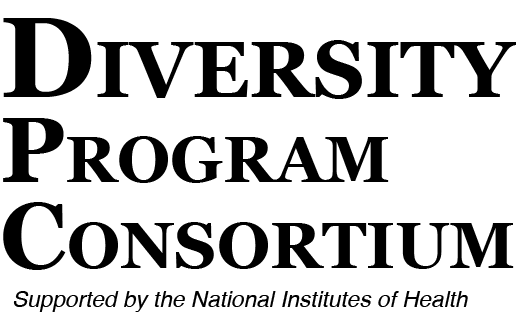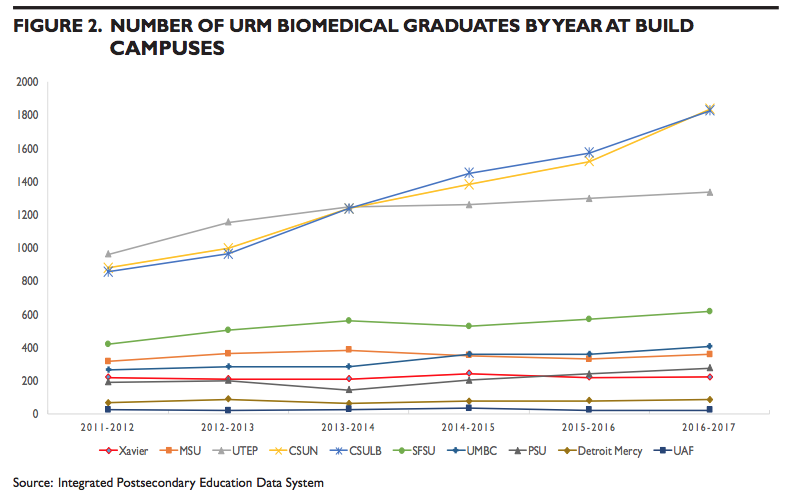



October 2018
A major NIH initiative is underway to determine the most effective ways to engage students from diverse backgrounds in biomedical research, and to prepare students to become potential future contributors to the NIH-funded research enterprise. The 10 grantees vary widely, from Historically Black Colleges and Universities (HBCUs), where most biomedical graduates are from underrepresented groups, to large public schools with moderate representation of underrepresented groups among their biomedical graduates. Graduation data from four years pregrant and two early years of the BUILD program show a general trend of constant proportions of underrepresented minority (URM) students graduating in biomedical majors, with a few institutions showing a rapid growth in the numbers that reflects overall increases in their number of students graduating with biomedical degrees over that time. Since few graduating students would have been involved in the new programs in the period shown, these trend data are best considered baseline or preintervention information that can be used in future years to help assess the institutional impact of the BUILD grants.
To help identify evidence-based strategies to best enhance the diversity of the National Institutes of Health (NIH)- funded workforce, NIH awarded a series of grants in 2014 to colleges and universities with limited NIH research funding and relatively high proportions of low-income students (RFA-RM-13-016). The Building Infrastructure Leading to Diversity (BUILD) grants are experimentally testing a variety of effective ways to engage students from underrepresented backgrounds in biomedical research in different environments. The projects are assessing different strategies to prepare students to become potential future contributors to the NIH-funded research enterprise, developing models to increase the diversity of students pursuing biomedical research careers through new programs targeting students, faculty, and the institutions.1
The Coordination and Evaluation Center (CEC) at UCLA is leading the national evaluation of this effort. The evaluation focuses on consortium-approved hallmarks, which include increasing the number of enrolled and retained underrepresented students in the biomedical sciences at the BUILD institutions. At the individual student level, one of the hallmarks is completion of an undergraduate degree in a biomedical discipline.a The NIH recognizes that its ability to help ensure that the nation remains a global leader in scientific discovery and innovation is dependent upon a pool of highly talented scientists from diverse backgrounds who will help to further NIH’s mission. Currently underrepresented groups in the scientific workforce include certain racial and ethnic groups, persons with disabilities, and those with financial or educationally disadvantaged backgrounds.2 The CEC is in the process of collecting data on the full range of underrepresented and well-represented groups through a series of surveys of students and faculty under the umbrella designation of the “enhance diversity” evaluation.

However, the most complete data available to assess undergraduate biomedical graduates at the institutional level is from the U.S. Department of Education’s Integrated Postsecondary Education Data System (IPEDS). This source has institutional level data on the number and proportion of students graduating with bachelor’s degrees who are from underrepresented minority (URM) groups for most colleges and universities across the country. URM in this analysis includes African Americans, Hispanics, American Indians/ Alaska Natives, Native Hawaiians and other Pacific Islanders.2
aHallmarks are short and long-term desired outcomes of the programs. The original DPC approved hallmarks included INST-B13 (increased number of biomedical student enrolled), INST-B3 (increased number of underrepresented students retained), and IND-B9 (completion of a degree in biomedical science). See https://www.nigms.nih.gov/training/dpc/Pages

One approach to assessing institutional change uses interrupted time-series models.3 The analysis involves documenting trends in an outcome for multiple time points before an intervention and then observing any changes in the trend after the intervention. BUILD grants were made in late 2014 and programs enrolled their first students in 2015 at the earliest. Even for programs that included juniors, the first BUILD graduates would have been in 2016- 17, and those first cohorts were very small and would not have had a measurable impact on that graduating class.
In addition to improving the educational and research outcomes of individual students and faculty directly involved in the BUILD programs, one of the goals of the initiative is to foster institutional change. To the extent that this occurs, we might expect to see changes in campus-level biomedical graduation numbers and/or percent of underrepresented students graduating. The six-year trends in the charts above are preintervention baseline trends that can be followed in subsequent years to determine the impact of BUILD on the numbers or proportions of URM students who graduate in biomedical majors at the grantee sites.
There was a wide range in the percent of graduates across BUILD institutions who are students from URM groups. During the preintervention period, the percentage of URM students among the biomedical graduates was generally the same during each year (Figure 1). Xavier and Morgan State University (MSU) are Historically Black Colleges and Universities (HBCUs) and already had very high percentages of URM students among their students graduating with biomedical majors.
Similarly, the University of Texas at El Paso is a Hispanic-serving institution where most of their students, and therefore biomedical graduates, were Hispanic. The California State Universities at Northridge (CSUN) and Long Beach (CSULB) had student bodies that were each about half URMs, which was reflected in the composition of their biomedical graduates. The percent of biomedical graduates who were URM students was similar to the overall campus representation of URM students in the other campuses as well.
Another important metric is the number of biomedical graduates who are URM students – especially for institutions that enrolled mostly URM students and where the percent cannot go higher. Improving the graduation rates of students in biomedical majors at those institutions, for example, would result in increased numbers of URM biomedical graduates. There was generally a consistent number of URM biomedical graduates over time at each institution before the implementation of BUILD programs, with the exceptions of CSUN and CSULB that show a near doubling in their numbers (Figure 2). In those two institutions, the numbers were consistent with a rapid growth in biomedical graduates overall. Similarly, UTEP had a modest increase in total biomedical graduates in the first years of this time series, which was reflected in the growing number of biomedical graduates who were URM students.
A bachelor’s degree is a key step towards a biomedical research career, and tracking changes from the baseline trends shown here will help document institutional-level changes in that step. The long-term success of the BUILD programs also involves increased numbers of underrepresented students continuing on to graduate school in the biomedical sciences with an interest in pursuing research careers. The CEC evaluation of the BUILD programs includes student-level data from the enhance diversity surveys on career intent and entry to graduate school at the individual level, which will complement the institutional trend analysis in the future.4
The lessons learned about successful strategies from the BUILD programs will be available for other institutions nationally to adopt so that they too can contribute to capturing unrealized talent that will enhance the biomedical workforce and improve the quality and relevance of biomedical science for the whole country.
Baseline trends in the graduation of URM students in biomedical majors at the BUILD institutions before their BUILD programs matured are reflective of the overall trends in biomedical majors and the racial/ethnic composition of their student body. One potential outcome of BUILD investments to transform the biomedical education at the institutional level at these sites is the proportion and/or numbers of URM biomedical graduates – metrics these baseline data will help us to assess in the coming years.5
Data for this brief are from the U.S. Department of Education, National Center for Education Statistics, Integrated Postsecondary Education Data System (IPEDS). https://nces.ed.gov/ipeds/use-the-data
Biomedical majors include both natural science disciplines as well as biomedical-related social and behavioral science areas where research is funded by the NIH and supported by the Diversity Program Consortium. https://www.diversityprogramconsortium.org/pages/biomedical_majors_list.
1Hurtado S, White-Lewis D, Norris K. Advancing inclusive science and systemic change: the convergence of national aims and institutional goals in implementing and assessing biomedical science training. BMC Proceedings 2017;11(12):17. https://doi.org/10.1186/s12919-017-0086-5
2Updated Notice of NIH’s Interest in Diversity. NOT-OD-18-210. July 16, 2018. Accessed 10/1/18 at https://grants.nih.gov/grants/guide/noticefiles/NOT-OD-18-210.html.
3St. Clair T, Cook TD, Hallberg K. Examining the internal validity and statistical precision of the comparative interrupted time series design by comparison with a randomized experiment. American Journal of Evaluation. 2014 ;35(3):311-27.
4Davidson PL, Maccalla NMG, Afifi AA, Guerrero, L, Nakazono TT, Zhong, S, Wallace SP. A participatory approach to evaluating a national training and institutional change initiative: The BUILD longitudinal evaluation. BMC Proceedings 2017 11(Suppl 12):15. https://rdcu.be/AnJU
5McCreath HE, Norris KC, Calderón NE, Purnell DL, Maccalla NMG, Seeman TE. Evaluating efforts to diversify the biomedical workforce: the role and function of the Coordination and Evaluation Center of the Diversity Program Consortium. BMC Proceedings 2017;11(12):27. https://doi.org/10.1186/s12919-017-0087-4
This data brief is published by the Diversity Program Consortium’s (DPC) Coordination and Evaluation Center (CEC) at UCLA.
info@diversityprogramconsortium.org
Brief #2018-03
